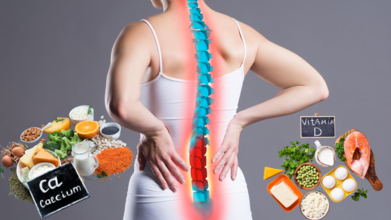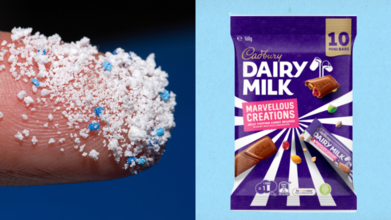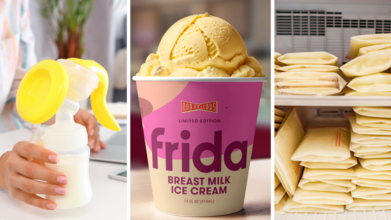- Health Conditions A-Z
- Health & Wellness
- Nutrition
- Fitness
- Health News
- Ayurveda
- Videos
- Medicine A-Z
- Parenting
- Web Stories
Dietician Shares Tips To Prevent Osteoporosis, Calls It A 'Silent Thief'

Credits: Canva
Dietician Omy Naidoo, based in South Africa, has recently shared his views on osteoporosis, which, he says, impacts 1 in 3 women in South Africa. The head dietician at Newtricion Wellness Institute, calls this a "Silent Thief", says it is because it can progress without any noticeable symptoms until a fracture occurs.
He also shares that lack of vitamin D and calcium are "massive drivers" for this condition, and recommends lifestyle changes. "Your peak bone mass, your highest reserve, is around your early to mid-20s. We have got to think of it quite routinely," he says in a podcast.
Furthermore, he also notes the importance of physical activities, especially resistance training, to enhance muscle mass, as this "creates a physical cushion to protect your bone structure".
What Dietary Changes Can Prevent Osteoporosis
Dairy Products
Low-fat and non-fat milk, yogurt, and cheese are excellent sources of calcium. Many dairy products are also fortified with vitamin D, which helps your body absorb calcium more effectively.
Fish
Some fish offer double benefits for bone health. Canned sardines and salmon (with bones) provide calcium, while fatty fish such as salmon, mackerel, tuna, and sardines are rich in vitamin D.
Fruits and Vegetables
Leafy greens like collard greens, kale, turnip greens, and Chinese cabbage are good calcium sources. Spinach, beet greens, okra, potatoes, sweet potatoes, and prunes supply magnesium, which works with calcium to maintain bone density. Potassium-rich foods such as bananas, papayas, and oranges help balance the body’s acid levels, protecting bone minerals. For vitamin C, which supports collagen formation in bones, look to red and green peppers, citrus fruits, strawberries, broccoli, and pineapples. Vitamin K, found in kale, collard greens, and Brussels sprouts, also plays a role in bone metabolism.
Fortified Foods
Some juices, breakfast cereals, soy milk, rice milk, breads, and snacks are fortified with calcium and vitamin D. Including these in your diet can help you reach your daily nutrient targets.
Other Potential Bone Boosters
Research hints that olive oil, soybeans, blueberries, and omega-3-rich foods like fish oil and flaxseed oil may also benefit bone health. While the evidence isn’t conclusive, their other health benefits make them worth adding to your meals.
Tips for Eating for Bone Health
Beans (Legumes)
Beans provide calcium, magnesium, and fiber, but they also contain phytates, which can block calcium absorption. Soaking beans before cooking and using fresh water can reduce phytate levels.
Protein
Adequate protein supports bone health, especially in older adults who may not get enough. However, very high-protein diets, particularly those heavy in meat, can increase calcium loss. Balance your intake by including protein sources that also contain calcium, like dairy.
Salty Foods
Too much sodium can cause calcium loss and weaken bones. Limit processed and canned foods, and check nutrition labels — a food is high in sodium if it has 20% or more of the daily value per serving. Aim for under 2,300 mg of sodium per day.
Oxalate-Rich Foods
Spinach, rhubarb, beet greens, and some beans are high in oxalates, which reduce calcium absorption. They still offer valuable nutrients but should not be counted as primary calcium sources.
Wheat Bran
100% wheat bran is the only food known to significantly reduce calcium absorption from other foods eaten at the same time. If you eat wheat bran cereal, consider taking calcium supplements at least two hours before or after.
Alcohol and Caffeine
Heavy alcohol use can lead to bone loss. Caffeine from coffee, tea, and sodas can interfere with calcium absorption, so consume these in moderation. Drinking more than three cups of coffee daily may have a negative effect.
Soft Drinks
Colas, which contain caffeine and phosphoric acid, may be linked to bone loss, especially if they replace milk or fortified drinks in your diet. The carbonation itself isn’t harmful, but ensure you’re still meeting your calcium needs.
A balanced diet with a variety of these nutrient-rich foods, along with healthy lifestyle habits, can go a long way toward keeping your bones strong for years to come.
Man Falls Ill After Seeking ChatGPT Advice on Cutting Salt

Credits: Canva
A U.S. medical journal has issued a cautionary note about relying on artificial intelligence for health guidance after a 60-year-old man developed a rare medical condition following advice he reportedly sought from ChatGPT about eliminating table salt from his diet.
Case Reported in Leading Medical Journal
The case, published in the Annals of Internal Medicine by researchers from the University of Washington, describes how the man developed bromism, also known as bromide toxicity, after substituting sodium chloride (table salt) with sodium bromide.
Bromism was a recognized condition in the early 20th century and is believed to have accounted for nearly one in ten psychiatric admissions at the time.
The man told doctors he had read about the negative effects of sodium chloride and consulted ChatGPT for alternatives. He said the chatbot mentioned that chloride could be replaced with bromide, albeit “likely for other purposes, such as cleaning.” Despite this, he began taking sodium bromide regularly for three months.
Sodium bromide, historically used as a sedative, has largely been abandoned in modern medicine due to safety concerns.
Unclear What Advice Was Originally Given
The researchers noted that they could not access the patient’s original ChatGPT conversation log, making it impossible to verify the exact wording or context of the advice. However, when the authors themselves asked ChatGPT about replacing chloride, the AI’s answer also mentioned bromide, provided no explicit health warning, and did not question the intent behind the inquiry.
“In our view, a medical professional would have sought clarification and avoided suggesting bromide for human consumption,” the authors wrote.
AI Risks in Medical Decision-Making
The authors warned that ChatGPT and other AI tools can produce scientifically inaccurate information, fail to critically evaluate potential risks, and unintentionally spread misinformation. They stressed that while AI may be useful in connecting scientific concepts with the public, it can also promote “decontextualized information” that could lead to preventable adverse health outcomes.
They recommended that medical professionals consider whether patients have been influenced by AI when assessing symptoms and history.
Patient’s Hospitalization and Symptoms
According to the report, the man arrived at a hospital believing his neighbor was trying to poison him. He presented with multiple dietary restrictions and paranoia, refusing water offered by staff despite being extremely thirsty. Within 24 hours, he attempted to leave the hospital, prompting his involuntary admission for psychiatric care.
He was diagnosed with psychosis and treated accordingly. Once stable, he reported additional symptoms characteristic of bromism, including facial acne, persistent thirst, and insomnia.
OpenAI’s Response and Recent Updates
The case predates the recent launch of ChatGPT’s latest version, GPT-5. OpenAI claims the updated model is better equipped to answer health-related queries and proactively flag potential concerns, including serious physical or mental health risks.
The company maintains that ChatGPT is not a substitute for professional medical care, a stance reflected in its user guidelines.
However, the University of Washington authors argue that even with advancements, AI tools should never be relied upon as primary sources for medical decision-making.
The report underscores a growing concern within the medical community: as AI becomes more integrated into daily life, patients may increasingly turn to chatbots for health advice without consulting qualified professionals. Experts say this case is a stark reminder of the dangers of self-medicating based on unverified or misunderstood online information.
Cadbury Australia Chocolate Recall: Why Your Body Is Already Home To Over 39,000 Microplastics And How To Cut Them Down

Australians who recently stocked up on Cadbury’s Marvellous Creations Jelly Popping Candy Beanies might want to check their cupboards. Cadbury Australia has recalled its 10-piece share bags (160g) after Food Standards Australia New Zealand (FSANZ) warned they may contain plastic.
The recall affects products with a best-before date of May 21, 2026, sold at Coles, Woolworths, Drakes, The Reject Shop, IGA, and other independent retailers.
The advice is clear: do not eat it. Return it for a refund, and if you have already consumed them, seek medical advice if you feel unwell. Cadbury assures that no other products are affected.
But the uncomfortable truth is that even if you avoid this recalled chocolate, there is still a good chance you are consuming plastic every single day. Wonder why I would say that? Read on...
While we all love a wholesome, clean meal, full of steamed veggies, a slice of grilled fish, and a glass of water, the burning question is if it is really clean. Invisible to the naked eye, lurking on that dinner plate could be thousands of microscopic plastic particles. From our kitchens to our bedrooms, plastic reigns supreme and it looks almost impossible to get rid of it. Anyway, let us get into the nitty-gritty of how we are directly or indirectly surrounded by plastic and what happens to our bodies.
The Effects of Microplastics on the Human Body
Plastic pollution has long been the most hated when it comes to environmental damage, but now it has got a more personal twist—it is in us. Microplastics, the tiny pieces and fibres that flake off larger plastic items or are manufactured at minuscule sizes, have stealthily infiltrated our food, our air, and even our bodies.
According to current research, the average person unknowingly ingests anywhere between 39,000 and 52,000 microplastic particles each year. And if you include breathing them in? The number climbs higher. We are inhaling and swallowing tiny plastic bits from seafood, vegetables, salt, and even the humble protein powder you down after yoga.
Also Read: Breast Milk Ice Cream Hits The Shelves, But Do Adults Really Need It?
The Pathways of Microplastics to the Human Body
How do these microplastics get in? The main pathway is oral intake—what we eat and drink. Microplastics have seeped into agricultural soil via sewage sludge, compost, and plastic mulching. From there, they travel up through plant roots and into fruits and vegetables. If you thought organic carrots were safe, they are not. If they are grown in contaminated soil, they are just organic carrots with sides of polyethylene.
Your Favourite Takeway
Takeaway food does not get off the hook either. Those aesthetic-looking plastic containers? They shed microplastics too. According to a report published in ACS Publications, if you are the kind to order in 4–7 times a week, you could be chomping down on an extra 12 to 203 microplastic fragments just from the packaging alone.
The Air You Breathe
Breathing is not safe either unless you have figured out how to inhale filtered mountain air all day. Most of the plastic in the air comes from roads like tyre dust and synthetic fibres floating invisibly around us. These tiny particles find their way into our lungs, and interestingly, scientists have found that the ones lodged deep in lung tissue are even smaller than what is floating in the atmosphere.
Skin-Deep Exposure
Skin contact, although less of a direct route, still adds to the exposure. Think face creams, scrubs with plastic microbeads, or even that trusty phone case. While our skin usually holds the line, it is not foolproof. Plastics can cling to us, ride into our systems via hand-to-mouth contact, or just hang around, increasing the risk of further exposure.
The Truly Unsettling Part?
Microplastics have been detected in human blood, liver, lungs, spleen, breast milk, and even the placenta. They have become part of us, literally. While the full scope of their long-term impact is still being researched, we already know they can cause oxidative stress, mess with our metabolism, interfere with the immune system, and wreak havoc on reproduction and development.
Small, mindful changes can help reduce your exposure
- Ditch the plastic water bottles and go for stainless steel or glass. Stop microwaving food in plastic because heat produces chemicals like BPA to leach into your food.
- Choose ceramic over plastic for food storage. Swap plastic chopping boards and utensils for hardwood and metal alternatives.
- Even your skincare routine could use a detox. Get mineral-based sunscreens and plastic-free moisturisers.
- Avoid detergent pods, scrutinise your tea bags, and maybe give your takeaway habit a little break.
Breast Milk Ice Cream Hits The Shelves, But Do Adults Really Need It?

Credits: Frida, Canva
Have you heard yet? The Breast milk ice cream by OddFellows and Frida is the hottest talk of the town. While the ice cream is actually not made with real breast milk, the taste is said to mimic it. It is a bit sweet, a bit salty and has hints of honey with a "dash of colostrum", states Frida's website. According to Frida's official press release, the company wanted to answer the question that everyone "secretly wondered": What does breast milk actually taste like?
The Press Release read, as published by People, "The ice cream will be a pitch-perfect representation of the sweet, creamy, nutrient-packed goodness we’ve all wanted to try but have been afraid to ask about. It will include some of the same nutrients — fats (Omega-3 brain fuel!), carbs (energy-boosting lactose), important vitamins (iron, calcium, vitamins B and D, and zinc), plus lots of H2O for hydration."
While the ice cream may not have been made from actual breast milk, many adults consume breast milk for purported health benefits. As per a 2015 study published in the Journal of the Royal Society of Medicine, adults are buying breast milk from online market. It is marketed as "super food" and has emerged as a craze among adults.
The study notes: "While breast milk has long been promoted as optimal for infant nutrition, among CrossFit, BodyBuilding, Palaeo and other fitness communities, fetishists, chronic disease sufferers and even foodies, breast milk is in demand. In the UK, breast milk ice cream is for sale. In the USA, a lollypop company sells a breast milk-flavoured sweet. Primarily, though, the milk is sold in its raw state, ready to drink."
But, is it really that necessary for adults to consume this "super food" made for the babies? Do fitness freak really need breast milk for muscles? To know answers to these questions, we spoke to Ms Edwina Raj, Head of Services, Clinical Nutrition & Dietetics at Aster CMI Hospital, Bengaluru.
Raj says that there is no scientific evidence that breast milk provides unique muscle gain or recovery benefits for adults beyond what regular protein sources offer.
Is Breast Milk For Adults?
"While it [breast milk] contains proteins, carbohydrates, fats, and growth factors ideal for infants, the protein content is relatively low compared to whey, casein, or plant-based protein powders commonly used by athletes. Claims that breast milk boosts performance often stem from its association with growth-promoting compounds for babies, but these do not have the same impact on fully developed adult bodies," explains Raj.
For adults, the muscle gain actually relies on adequate protein intake, balanced diet and proper training.
Do Adults REALLY Need This "Super Food"?
The main claim that makes breast milk so enticing even to adults is that it provides all essential nutrients for one to sustain. However, explains Raj, the nutrients in breast milk can be matched. Though, she agrees that it cannot mimic the benefits of immunonutrients. However, Raj says that other key components like proteins, healthy fats, carbohydrates, vitamins, minerals, and beneficial compounds are all readily available in a balanced diet.
For example, high-quality protein from eggs, dairy, lean meats, legumes, and whey supplements can exceed breast milk’s protein content, while omega-3 fatty acids from fish, flaxseeds, and walnuts offer equal or greater heart and brain benefits. Vitamins and minerals found in breast milk can be obtained from fruits, vegetables, whole grains, and fortified foods. Even immune-supporting and gut-friendly compounds can be obtained through probiotics, prebiotics, and nutrient-rich foods.
Raj says, "[Breast milk] it doesn’t offer any essential nutritional benefits to healthy adults that they can’t get from regular foods or supplements. Its proteins, healthy fats, vitamins, and minerals can all be obtained from a balanced diet, and the immune-boosting antibodies in breast milk are most effective for developing infant immune systems, not fully matured adult ones."
Hygiene Issues
For products like breast milk ice cream, strict hygiene and safety checks are essential to ensure it’s safe for adult consumption.
Raj notes that the donor must be screened for infectious diseases such as HIV, hepatitis B and C, syphilis, and other transmissible illnesses, similar to blood donation protocols.
Although breast milk flavoring ingredient may be of small amount but the milk should be collected using sterile equipment, handled with gloved hands, and stored at safe temperatures to prevent bacterial growth.
"Pasteurization is crucial to kill harmful bacteria and viruses without significantly altering nutritional content. Production facilities must follow food safety regulations, including contamination control, regular microbial testing, and proper labelling," she says.
Consumers should only source such products from regulated, tested suppliers, as untested breast milk can carry serious health risks for adults.
Talking about the breast milk flavoured ice cream, she says, "Breast milk flavored ice cream can shock the consumer yet cannot be superior to what a balanced adult diet can provide, and the immune-boosting properties mainly benefit infants, for its benefit in adults are yet to be studied."
"As long as it’s made under strict safety standards, it can be a quirky treat but not a game-changer in adult nutrition," she says.
© 2024 Bennett, Coleman & Company Limited

